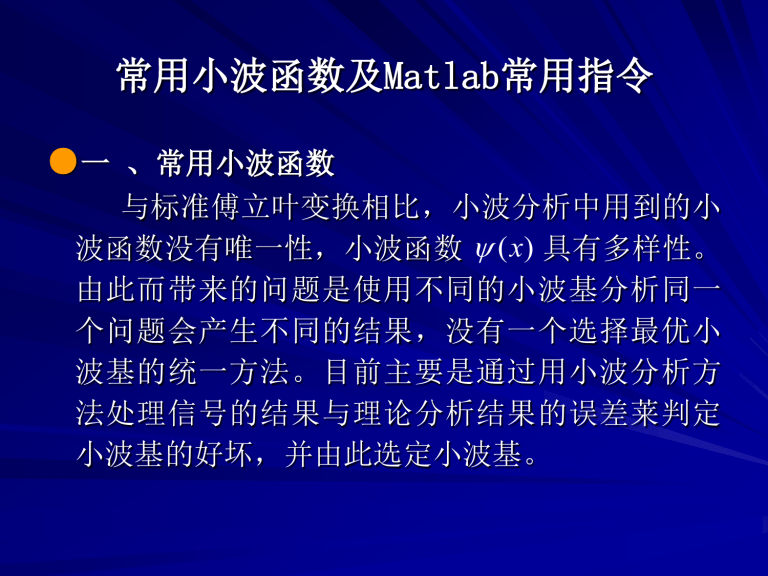常用小波函数及Matlab常用指令
advertisement

常用小波函数及Matlab常用指令
●一 、常用小波函数
与标准傅立叶变换相比,小波分析中用到的小
波函数没有唯一性,小波函数 ( x) 具有多样性。
由此而带来的问题是使用不同的小波基分析同一
个问题会产生不同的结果,没有一个选择最优小
波基的统一方法。目前主要是通过用小波分析方
法处理信号的结果与理论分析结果的误差莱判定
小波基的好坏,并由此选定小波基。
常用的指导性选择标准有:
(1)
、
、、
^
^
的支撑长度。即当时间或频
率趋于无穷大时,上述各量从有限值收敛到0的速
度;
(2) 对称型。它在图象处理中对于避免移相非常有用;
(3) 和 (若存在)的消失矩阶数。对于压缩非常
有用;
(4)正则性。对信号或图象的重构获得较好的平滑效
果非常有用。
1、Haar 小波
1
0 x 1/ 2
H 1 1/ 2 x 1
0
其他
waveinfo('haar')
HAARINFO Information on Haar wavelet.
Haar Wavelet
General characteristics: Compactly supported
wavelet, the oldest and the simplest wavelet.
scaling function phi = 1 on [0 1] and 0 otherwise.
wavelet function psi = 1 on [0 0.5[, = -1 on [0.5 1] and 0 otherwise.
Family
Short name
Examples
Haar
haar
haar is the same as db1
Orthogonal
Biorthogonal
Compact support
DWT
CWT
yes
yes
yes
possible
possible
Support width
1
Filters length
2
Regularity
haar is not continuous
Symmetry
yes
Number of vanishing moments for psi
1
图:
在命令窗口输入waveinfo('haar')
2、db系列小波
DBINFO Information on Daubechies wavelets.
Daubechies Wavelets
General characteristics: Compactly supported
wavelets with extremal phase and highest
number of vanishing moments for a given
support width. Associated scaling filters are
minimum-phase filters.
Family
Daubechies
Short name
db
Order N
N strictly positive integer
Examples
db1 or haar, db4, db15
Orthogonal
yes
Biorthogonal
yes
Compact support
yes
DWT
possible
CWT
possible
Support width
2N-1
Filters length
2N
Regularity
about 0.2 N for large N
Symmetry
far from
Number of vanishing moments for psi
N
图:
3、Biorthogonal(biorNr.Nd)小波系
主要特点体现在具有线性相位型,主要应用于信
号和图象的重构中。通常表示为biorNr.Nd形式。
Nr=1
Nd=1,3,5;
Nr=2
Nr=3
Nd=1,3,5,7,9; Nr=4
Nd=4
Nr=5
Nd=5;
Nd=8
Nr=6
Nd=2,4,6,8
General characteristics: Compactly supported
biorthogonal spline wavelets for which symmetry and
exact reconstruction are possible with FIR filters (in
orthogonal case it is impossible except for Haar).
Family
Short name
Order Nr,Nd
r for reconstruction
d for decomposition
Biorthogonal
bior
Nr = 1 , Nd = 1, 3, 5
Nr = 2 , Nd = 2, 4, 6, 8
Nr = 3 , Nd = 1, 3, 5, 7, 9
Nr = 4 , Nd = 4
Nr = 5 , Nd = 5
Nr = 6 , Nd = 8
Examples
bior3.1, bior5.5
Orthogonal(正交) no
Biorthogonal(双正交的) yes
Compact support
yes
DWT
possible
CWT
possible
Support width
2Nr+1 for rec.,
2Nd+1 for dec.
Filters length
max(2Nr,2Nd)+2 but
essentially
bior Nr.Nd
bior 1.1
bior 1.3
bior 1.5
bior 2.2
bior 2.4
bior 2.6
bior 2.8
ld
effective length
of Lo_D
2
6
10
5
9
13
17
lr
effective length
of Hi_D
2
2
2
3
3
3
3
bior 3.1
bior 3.3
bior 3.5
bior 3.7
bior 3.9
bior 4.4
bior 5.5
bior 6.8
4
8
12
16
20
9
9
17
4
4
4
4
4
7
11
11
Regularity for psi rec. Nr-1 and Nr-2 at the
knots
Symmetry
yes
Number of vanishing moments for psi dec.
Nr
Remark: bior 4.4 , 5.5 and 6.8 are such
that reconstruction and
decomposition functions and filters are
close in value.
图:
4、Coiflet(coifN)小波系
由Daubechies构造,N=1,2,3,4,5.具有比dbN更好的
对称性。从支撑长度看,具有和db3N及sym3N具有
相同的支撑长度,从消失矩的数目看,具有和db2N
和symN相同的消失矩数目。
图:
General characteristics: Compactly supported
wavelets with highest number of vanishing
moments for both phi and psi for a given
support width.
Family
Coiflets
Short name
coif
Order N
N = 1, 2, ..., 5
Examples
coif2, coif4
Orthogonal
yes
Biorthogonal
yes
Compact support
yes
DWT
possible
CWT
possible
Support width
6N-1
Filters length
6N
Regularity
Symmetry
near from
Number of vanishing moments for psi
2N
Number of vanishing moments for phi
2N-1
5、SymletsA(symN)小波系
Symlets函数系由Daubechies提出的近似对称的小波
函数,是对db函数的改进,N=2,3,…,8。
General characteristics: Compactly
supported wavelets with least asymmetry
and highest number of vanishing moments
for a given support width.
Associated scaling filters are near
linear-phase filters.
Family
Symlets
Short name
sym
Order N
N = 2, 3, ...
Examples
sym2, sym8
Orthogonal
yes
Biorthogonal
yes
Compact support
yes
DWT
possible
CWT
possible
Support width
2N-1
Filters length
2N
Regularity
Symmetry
near from
Number of vanishing moments for psi
N
●6、Molet(morl)小波
x 2/ 2
小波函数为:
(x)=Ce
cos5x
尺度函数不存在,不具有正交性。
Definition: morl(x) = exp(-x^2/2) * cos(5x)
Family
Morlet
Short name
morl
Orthogonal
no
Biorthogonal
no
Compact support
no
DWT
no
CWT
possible
Support width
Effective support
Symmetry
infinite
[-4 4]
yes
7、Mexican Hat (mexh)小波
由Gauss函数的二阶导数构成。
2 1 / 4
(x)= (1 x 2 )e x 2 / 2
3
具有很好的时频局部化能力,尺度函数不存在,不
具有正交性。
Definition: second derivative of the Gaussian
probability density function
mexh(x) = c * exp(-x^2/2) * (1-x^2) where
c = 2/(sqrt(3)*pi^{1/4})
Family
Short name
Orthogonal
Biorthogonal
Compact support
DWT
CWT
Support width
Effective support
Symmetry
Mexican hat
mexh
no
no
no
no
possible
infinite
[-5 5]
yes
8、Meyer小波
其小波函数和尺度函
数在频率域定义,为
具有紧支撑的正交小
波。
二、小波分析工具箱常用函数介绍
1、Cwt
功能:一维连续小波变换
格式:(1)coefs=cwt(s,scales,’wname’)
(2)coefs=cwt(s,scales,’wname’,’plot’)
s为待分析信号;
scales为尺度向量:可以为离散值,表示为
[a1,a2,a3 ,…];也可以为连续值,表示为
[amin:step:amax];还可以是混合情况,需要将离散
值写前面,连续值写后面
[a1,a2,a3 ,amin:step:amax]
返回值为小波变换系数矩阵,矩阵的行数为尺度个
数,每一行的值为该尺度小波变换系数
在命令窗口输入 help cwt,可得指令的功能解释。
help cwt
CWT Real or Complex Continuous 1-D wavelet
coefficients.
COEFS = CWT(S,SCALES,'wname') computes
the continuous
wavelet coefficients of the vector S at real,
positive
SCALES, using wavelet whose name is 'wname'.
The signal S is real, the wavelet can be real or
complex.
COEFS = CWT(S,SCALES,'wname','plot')
computes
and, in addition, plots the continuous wavelet
transform coefficients.
COEFS =
CWT(S,SCALES,'wname',PLOTMODE)
computes and,plots the continuous wavelet
transform coefficients.
Coefficients are colored using PLOTMODE.
PLOTMODE = 'lvl' (By scale) or
PLOTMODE = 'glb' (All scales) or
PLOTMODE = 'abslvl' or 'lvlabs' (Absolute
value and By scale) or
PLOTMODE = 'absglb' or 'glbabs' (Absolute
value and All scales)
………
%一维连续小波变换
load noissin;
s=noissin(1:100);
ls=length(s);
w=cwt(s,[12.12,10.24,15.48,1.2,2:2:10],'db
3','plot');
xlabel('时间')
ylabel('变换尺度')
2、单尺度一维离散小波变换
格式:(1)[ca,cd]=dwt(x,’wname’)
(2)[ca,cd]=dwt(x,Lo-D,Hi-D)
方式(1)直接对信号在指定的小波形式下进行
分解,ca为低频系数,cd为高频系数;
方式(2)先利用小波滤波器指令wfilters求取
分解用的低通和高通滤波器,然后将信号通过滤
波器进行分解,可以达到同样的效果。
%单尺度一维离散小波变换;
load noissin; s=noissin(1:1000);
subplot(411);plot(s)
[ca1,cd1]=dwt(s,'haar');
subplot(423);plot(ca1)
ylabel('haar(ca1)');
subplot(424);plot(cd1);
ylabel('haar(cd1)');
[lo_d,hi_d]=wfilters('haar','d');
[ca2,cd2]=dwt(s,lo_d,hi_d);
subplot(4,2,5);plot(ca2)
ylabel('haar(ca2)');
subplot(4,2,6);plot(cd2)
ylabel('haar(cd2)');
3 单尺度一维离散小波逆变换idwt
功能:单尺度一维离散小波逆变换
X = idwt(CA,CD,'wname') ;
X = idwt(CA,CD,Lo_R,Hi_R);
X = idwt(CA,CD,'wname',L) ;
X = idwt(CA,CD,Lo_R,Hi_R,L)
后两种对信号中间长度为L 的部分进行重构
%单尺度一维离散小波逆变
换
load noissin;
s=noissin(1:1000);
subplot(6,2,1);
plot(s)
title('原始信号')
[ca1,cd1]=dwt(s,'db2');
x1=idwt(ca1,cd1,'db2');
subplot(6,2,5)
plot(x1)
title('小波重构')
errx1max=max(abs(s-x1));
errx1=s-x1;
subplot(626)
plot(errx1)
title('小波重构误差')
axis([0,1000,-2e-11,2e-11]);
•[lo_d,hi_d,lo_r,hi_r]=wfilters
('db2');
•[ca,cd]=dwt(s,lo_d,hi_d);
•x2=idwt(ca,cd,lo_r,hi_r);
•subplot(6,2,9);
•plot(x2);
•title('滤波器重构')
•errx2max=max(abs(s-x2))
•errx2=s-x2;
•subplot(6,2,10);plot(errx2)
•title('滤波器重构误差');
•axis([0,1000,-2e-11,2e-11]);
4、小波滤波器wfilters
格式:
(1)[Lo-D,Hi-D,Lo-R,Hi-R]=wfilters(‘wname’)
(2)[f1,f2]=wfilters(‘wname’,’type’)
[LO_D,HI_D,LO_R,HI_R] = WFILTERS('wname')
computes four filters associated with the
orthogonal or biorthogonal wavelet named in the
string 'wname'.
LO_D, the decomposition low-pass filter
HI_D, the decomposition high-pass filter
LO_R, the reconstruction low-pass filter
HI_R, the reconstruction high-pass filter
[F1,F2] = WFILTERS('wname','type') returns the
following filters:
LO_D and HI_D if 'type' = 'd' (Decomposition filters)
LO_R and HI_R if 'type' = 'r' (Reconstruction filters)
LO_D and LO_R if 'type' = 'l' (Low-pass filters)
HI_D and HI_R if 'type' = 'h' (High-pass filters)
’type’=‘d’ 分解滤波器
器
’type’=‘l’ 低通滤波器
波器
’type’=‘R’ 重构滤波
’type’=‘h’ 高通滤
举例
[lo_d,hi_d,lo_r,hi_r]=wfilters('haar');
figure(1);subplot(221);
stem(lo_d);title('lo-d of haar');
subplot(222)
stem(hi_d);title('hi-d of haar')
subplot(223);stem(lo_r);
title('lo-r of haar')
subplot(224)
stem(hi_r)
title('hi-r of haar')
5、dwtmode
功能:离散小波变换拓展模式
格式: (1)dwtmode
(2)dwtmode(‘mode’)
说明:当对信号或图像的边缘进行处理时,需要
信号的边缘进行拓展。拓展模式有三种。该指令
在进行离散小波变换或小波包变换时,进行模式
拓展设定。
模式类型
类型说明
zdp
补零模式,缺省设定
sym
对称延拓模式,即把
边缘值进行复制
spd
平滑模式,对信号边
缘进行某种平滑处理
6、wavedec
功能:多尺度一维小波分解(一维多分辨分析函
数)
格式:(1)[c,l]=wavedec(x,n,’wname’)
(2)[c,l]=wavedec(x,n,Lo-D,Hi-D)
用小波或分解滤波器对信号X进行一维多尺度分解,
n为尺度和正整数。
输出参数c是由 [ca j , cd j , cd j 1 , , cd1 ] 组成,L是由
[ca 的长度, cd 的长度, cd 的长度, , cd 的长度] 组成。
j
j
j 1
1
图:
x
ca1
ca2
ca3
C:
ca3 cd3
cd1
cd2
cd3
cd2
cd1
L: ca3的长度 cd3的长度 cd2的长度 cd1的长度 x的长度
举例
%多尺度一维离散小波变换;
load sumsin;
s=sumsin;
subplot(611)
plot(s);
title('原始信号')
[c,l]=wavedec(s,3,'db1');
subplot(613)
plot(c);
title('信号s3尺度分解');
L= 125
125
250
500
1000
7、appcoef
功能:提取一维小波变换低频系数
格式:(1)A=appcoef(c,l,’wname’,N)
(2)A=appcoef(c,l,’wname’)
(3)A=appcoef(c,l,Lo-R,Hi-R )
(4)A=appcoef(c,l,Lo-R,Hi-R ,N)
说明:该函数是一个一维小波分解函数,用于从
小波分解结构[C,L]中提取一维信号的低频
系数。
格式(1)计算尺度N时的低频系数,
格式(2)用于提取最后一个尺度的低频系数,
格式(3)和(4)用滤波器提取低频系数。
举例
%提取一维小波变换低频
系数;
load leleccum;
s=leleccum(1:2000)
subplot(421)
plot(s);
title('原始信号')
[c,l]=wavedec(s,3,'db1');
ca1=appcoef(c,l,'db1',1);
subplot(445)
plot(ca1)
ylabel('ca1');
ca2=appcoef(c,l,'d
b1',2);
subplot(4,8,17)
plot(ca2);
ylabel('ca2');
8、Detcoef
功能:提取一维信号小波变换高频系数
格式:(1)d=detcoef(c,l,N) 提取N尺度的高频系
数。
(2) d=detcoef(c,l),提取最后一尺度的
高频系数。
举例
%提取一维小波变换高
频系数;
load leleccum;
s=leleccum(1:2000)
subplot(421)
plot(s);
title('原始信号')
[c,l]=wavedec(s,3,'db1');
cd1=detcoef(c,l,1);
subplot(445)
plot(cd1)
ylabel('cd1');
cd2=detcoef(c,l,2);
subplot(4,8,17)
plot(cd2);
ylabel('cd2');
九、Waverec
功能:多尺度一维小波重构
格式:(1)x=waverec(c,l,’wname’)
(2)x=waverec(c,l,Lo-R,Hi-R)
(3)x= waverec(wavedec
(x,N,’wavename’),’ wavename’)
说明:该函数用指定的小波函数或重构滤波器对
小波分解结构(C,L)进行多尺度一维小波重构。
举例
%多尺度一维小波重
构;
load leleccum;
s=leleccum(1:3920)
subplot(311)
plot(s);
title('原始信号')
[c,l]=wavedec(s,3,'d
b5');
a=waverec(c,l,'db5')
subplot(312)
plot(a)
title('重构信号')
err=s-a;
subplot(313)
plot(err)
title('误差')
十、 upwlev
功能:单尺度一维小波分解的重构
格式:(1)[nc,nl,ca]=upwlev(c,l,’wname’)
(2) [nc,nl,ca]=upwlev(c,l,Lo-R, Hi-R)
说明:该函数用于对小波分解结构[C,L]进行单尺
度重构,返回上一尺度的分解结构并提取最后一
尺度的低频分量。
%单尺度一维小波分解的重构;
load sumsin;
s=sumsin;
subplot(611)
plot(s);
title('原始信号')
[c,l]=wavedec(s,3,'db1');
subplot(613)
plot(c)
title('尺度3的小波分解结构')
xlabel('尺度3的低频系数和尺度3、2、1的高频系数')
[nc,nl]=upwlev(c,l,'db1'); 等效于[c,l]=wavedec(s,2,'db1')
subplot(615);
plot(c)
plot(nc);
title('尺度2的小波分解结构')
xlabel('尺度2的低频系数和尺度2、1的高频系数')
L= 125
125
250
500
1000
NL=250
250
500
1000
十一、Wrcoef
功能:对一维小波系数进行单支重构
格式:(1)x=wrcoef(‘type’,c,l,’wname’,N)
(2)x=wrcoef(‘type’,c,l,Lo-R,Hi-R,,N)
(3)x=wrcoef(‘type’,c,l,’wname’)
(4)x=wrcoef(‘type’,c,l,Lo-R,Hi-R)
说明:对一维信号的分解结构[C,L]用指定的小波
函数或重构滤波器进行重构。当‘type=a’时,对
信号的低频部分进行重构,此时N可以为0;当
‘type=d’时,对信号的高频部分进行重构,此时
N为正整数。
%对一维小波系数进行单支重构;
load sumsin;
s=sumsin;
subplot(611)
plot(s);
title('原始信号')
[c,l]=wavedec(s, 5,'sym4');
a5=wrcoef('a',c,l,'sym4',5);
subplot(613)
plot(a5)
title('低频部分重构信号')
a51=wrcoef('d',c,l,'sym4',5);
subplot(615)
plot(a51)
title('高频部分重构信号')
十二、upcoef
功能:一维系数的直接小波重构
格式:(1)y=upcoef(‘0’,x,’wname’,N)
(2) y=upcoef(‘0’,x,’wname’,N,L)
(3) y=upcoef(‘0’,x,Lo-R,Hi-R,N)
(4) y=upcoef(‘0’,x,Lo-R,Hi-R,N,L)
(5) y=upcoef(‘0’,x,’wname’)
(6) y=upcoef(‘0’,x,Lo-R,Hi-R)
说明:该函数用于一维小波分析,它用来计算向
量X(信号系数)向上N步的重构小波系数,N为正
整数。如果0=a,对低频系数进行重构;如果0=
d,对高频系数进行重构;对于(2)和(4),则
是对向量X中间长度为L部分进行重构。
Load leleccum; s= leleccum(1:2000);
Plot(s)
cd1=detcoef(c,l,1);
title('原始信号');
scd1=upcoef('d',cd1,'db6',1);
[c,l]=wavedec(s,3,'db6');
subplot(626);plot(scd1);
ca1=appcoef(c,l,'db6',1);
title('尺度1的高频系数cd1
sca1=upcoef('a',ca1,'db6',1);
向上一步重构信号');
subplot(622);plot(sca1);
axis([0,2000,-20,20]);
title('尺度1的低频系数ca1
[f1,f2]=wfilters('db6','r');
向上一步重构信号');
ca2=appcoef(c,l,'db6',2);
axis([0,2000,200,600]);
sca2=upcoef('a',ca2,f1,f2,2);
sca1l=upcoef('a',ca1,'db6',1,1000);
subplot(629);plot(sca2);
subplot(625);plot(sca1l);
title('尺度2的低频系数ca2
title(‘ca1向上一步只取1000
向上2步重构信号');
点重构信号');
axis([0,2000,200,600]);
axis([0,2000,200,600]);
十三、wpdec
功能:一维小波包的分解
格式:(1)T=wpdec(X, N, ’wname’, E, P)
说明:wpdec是一个一维小波包分解函数。
它根据小波函数’wname’(参见wfilters)、熵标准E和参数P对信
号X进行N层小波包分解,并返回小波包分解结构T, T为树结构。
E is a string containing the type of entropy (see WENTROPY):
E = 'shannon', 'threshold', 'norm', 'log energy', 'sure', 'user’.
P is an optional parameter:
'shannon' or 'log energy': P is not used
'threshold' or 'sure' : P is the threshold (0 <= P)
'norm' : P is a power (1 <= P)
'user':P is a string containing the name of an user-defined function.
load noisdopp;
x=noisdopp;
t=wpdec(x,3,'db1','shannon');
plot(t)
data for node: (0) or (0,0).
Tree Decomposition
10
8
(0,0)
6
4
(1,1)
(1,0)
2
0
(2,0)
(2,1)
(2,2)
(2,3)
-2
-4
-6
(3,0) (3,1) (3,2) (3,3) (3,4) (3,5) (3,6) (3,7)
-8
-10
200
400
600
800
1000
Tree Decomposition
data for node: (1) or (1,0).
15
(0,0)
10
(1,0)
5
(1,1)
0
(2,0)
(2,1)
(2,2)
(2,3)
-5
-10
(3,0) (3,1) (3,2) (3,3) (3,4) (3,5) (3,6) (3,7)
-15
100
200
300
400
500
Tree Decomposition
data for node: (2) or (1,1).
3
(0,0)
2
1
(1,0)
(1,1)
0
-1
(2,0)
(2,1)
(2,2)
(2,3)
-2
-3
(3,0) (3,1) (3,2) (3,3) (3,4) (3,5) (3,6) (3,7)
-4
100
200
300
400
500
Tree Decomposition
data for node: (3) or (2,0).
20
(0,0)
15
10
(1,0)
(1,1)
5
0
(2,0)
(2,1)
(2,2)
(2,3)
-5
-10
(3,0) (3,1) (3,2) (3,3) (3,4) (3,5) (3,6) (3,7)
-15
50
100
150
200
250
Tree Decomposition
data for node: (4) or (2,1).
5
(0,0)
4
3
(1,0)
2
(1,1)
1
0
(2,0)
(2,1)
(2,2)
(2,3)
-1
-2
(3,0) (3,1) (3,2) (3,3) (3,4) (3,5) (3,6) (3,7)
-3
-4
50
100
150
200
250
Tree Decomposition
data for node: (5) or (2,2).
3
(0,0)
2
1
(1,0)
(1,1)
0
-1
(2,0)
(2,1)
(2,2)
(2,3)
-2
-3
(3,0) (3,1) (3,2) (3,3) (3,4) (3,5) (3,6) (3,7)
-4
50
100
150
200
250
Tree Decomposition
data for node: (6) or (2,3).
4
(0,0)
3
2
(1,0)
(1,1)
1
0
(2,0)
(2,1)
(2,2)
(2,3)
-1
-2
(3,0) (3,1) (3,2) (3,3) (3,4) (3,5) (3,6) (3,7)
-3
50
100
150
200
250
Tree Decomposition
data for node: (7) or (3,0).
20
(0,0)
15
10
(1,0)
5
(1,1)
0
-5
(2,0)
(2,1)
(2,2)
(2,3)
-10
-15
(3,0) (3,1) (3,2) (3,3) (3,4) (3,5) (3,6) (3,7)
-20
-25
20
40
60
80
100
120
十四、wprec
功能:一维小波分解的重构
格式: x=wprec(t)
举例:
load noisdopp; x=noisdopp;
figure(1);subplot(211);plot(x)
title('原始信号')
t=wpdec(x,3,'db1','shannon');
x1=wprec(t)
subplot(212)
plot(x1)
title('重构信号')
十五、wpcoef
功能:计算小波系数
格式: (1)x=wpcoef(t,n)
(2) x=wpcoef(t)
说明: wpcoef是一个一维或二维的小波包
分析函数。格式(1)返回与节点n对应的
系数。如果n不存在,x=[];
x=wpcoef(t)等效于x= wpcoef(t,0)
subplot(323);
load noisdopp;
x=noisdopp;
figure(1)
subplot(311)
plot(x)
title('原始信号')
t=wpdec(x,3,'db1','shannon');
cfs21=wpcoef(t,[2,1]);
cfs22=wpcoef(t,[2,2]);
cfs31=wpcoef(t,[3,1]);
cfs32=wpcoef(t,[3,2]);
plot(cfs21);
title('小波包[2,1]的系数');
subplot(324);
plot(cfs22);
title('小波包[2,2]的系数');
subplot(325);
plot(cfs31);
title('小波包[3,1]的系数');
subplot(326);
plot(cfs32);
title('小波包[3,2]的系数');
原始信号
10
5
0
-5
-10
0
200
400
600
800
1000
小 波 包 [2,0]的 系 数
1200
小 波 包 [2,1]的 系 数
20
10
10
5
0
0
-10
-20
0
50
100
150
200
250
300
-5
0
50
100
小 波 包 [3,0]的 系 数
150
200
250
300
小 波 包 [3,1]的 系 数
20
10
5
0
0
-20
-40
-5
0
20
40
60
80
100
120
140
-10
0
20
40
60
80
100
120
140
十六、wprcoef
功能:小波包分解系数的重构;
格式:x= wprcoef(t,n)
说明: wprcoef是一个一维或二维的小波包
分析函数,计算节点n的小波包分解系数的
重构信号。
X= wprcoef(t)= wprcoef(t,0)
该函数一次只能对一个节点进行重构,不能
同时对多点进行重构,可以通过多次调用
实现。
load noisdopp;
x=noisdopp(1:1000);
figure(1)
subplot(311)
plot(x)
title('原始信号')
t=wpdec(x,3,'db1','shannon');
rcfs=wprcoef(t,[2,0]);
cfs21=wpcoef(t,[2,0]);
subplot(312)
plot(cfs21)
title(‘小波包节点(2,0)系数')
subplot(313)
plot(rcfs)
title(‘重构小波包节点(2,0)信号')
十七、wpfun
功能:小波包函数
格式: [WPWS,X] = WPFUN('wname',NUM,PREC)
computes the wavelets packets for a wavelet 'wname'
(see WFILTERS), on dyadic intervals of length
1/2^PREC. PREC must be a positive integer.
Output matrix WPWS contains the W functions of
index from 0 to NUM, stored rowwise as [W0; W1;...;
Wnum]. Output vector X is the corresponding common
X-grid vector.
[WPWS,X] = WPFUN('wname',NUM) is equivalent to
[WPWS,X] = WPFUN('wname',NUM,7).
十八、wpsplt
功能:分解(分割)小波包
格式:t= wpsplt(t,n)
returns the modified tree t corresponding to the
decomposition of the node n.
[t,ca,cd] = wpsplt(t,n)
with ca = approximation and cd = detail of node
n for a 1-D decomposition.
[t, ca,ch,cv,cd] = WPSPLT(T,N)
with ca = approximation and ch, cv, cd = (Horiz.,
Vert. and Diag.) details of node n for a 2-D
decomposition(二维小波变换)
举例
load noisdopp;
x=noisdopp(1:1000);
figure(1)
subplot(311)
plot(x)
title('原始信号')
t=wpdec(x,3,'db1','shannon');
plot(t)
[wpt,wpd]=wpsplt(t,[3,0]);
plot(wpt)
十九、wpjoin
功能:重新组合小波包
格式及说明:
t = wpjoin(t,n) returns the modified tree t
corresponding to a recomposition of the node n.
t = wpjoin(t) is equivalent to t = wpjoin(t,0).
[t,x] = wpjoin(t,n) also returns the coefficients
of the node n。
[t,x] = wpjoin (t) is equivalent to [t,x] = wpjoin(t,0)
load noisdopp;
x=noisdopp(1:1000);
figure(1)
subplot(321)
plot(x)
title('原始信号')
t=wpdec(x,3,'db1','shannon');
plot(t)
[wpt,wpc]=wpjoin(t,[1,1]);
plot(wpt)
figure(1)
subplot(322)
plot(wpc)
title('节点2的小波包分解系数')
二十、wpcutree
功能:剪切小波包分解树
格式及说明:
t = wpcutree(t,L) cuts the tree t at level L.
In addition, [t,rn] = wpcutree(t,L) returns
the vector rn which contains the indices
of the reconstructed nodes.
举例
load noisdopp;
x=noisdopp(1:1000);
figure(1)
subplot(211)
plot(x)
title('原始信号')
t=wpdec(x,3,'db1','shannon');
plot(t)
[wpt,rn]=wpcutree(t,2);
plot(wpt)
rn=3,4,5,6
二十一、besttree
功能:计算最佳树
格式及说明:
BESTTREE computes the optimal sub-tree of an initial tree
with respect to an entropy type criterion. The resulting tree may
be much smaller than the initial one.
T = BESTTREE(T) computes the modified tree T corresponding to
the best entropy value.
[T,E] = BESTTREE(T) returns the best tree T and in addition, the
best entropy value E.
The optimal entropy of the node whose index is j-1 is E(j).
[T,E,N] = BESTTREE(T) returns the best tree T, entropy value E
and in addition, the vector N containing the indices of the merged
nodes.
举例
load noisdopp;
x=noisdopp;
t=wpdec(x,3,'db1','shannon');
x1=wprec(t);
[wpt,wpca,wpcd]=wpsplt(t,[3,0]);
plot(wpt)
[bt,e,n]=besttree(wpt);
plot(bt)
e'
ans =
1.0e+004 *
Columns 1 through 8
-9.8173 -9.7822 -0.0350 -9.7303 -0.0519 -9.5880 -0.1423 0.0318
Columns 9 through 11
-0.0200 -9.3112 -0.2768
n=2
二十二、bestlevt
计算完整最佳小波包树
BESTLEVT computes the optimal complete sub-tree of
an initial tree with respect to an entropy type criterion.
The resulting complete tree may be of smaller depth
than the initial one.
T = BESTLEVT(T) computes the modified tree T
corresponding to the best level tree decomposition.
[T,E] = BESTLEVT(T) returns best tree T and in addition,
the best entropy value E.
The optimal entropy of the node whose index is j-1 is
E(j).
load noisdopp;
x=noisdopp;
t=wpdec(x,3,'db1','shannon');
[wpt,wpca,wpcd]=wpsplt(t,[3,0]);
plot(wpt)
[blt,e]= bestlevt(wpt);
plot(blt)
e'
ans =
1.0e+004 *
Columns 1 through 8
-5.8615 -6.8204 -0.0350 -7.7901 -0.0497 -0.0205 -0.0138
-8.6844
Columns 9 through 15
-0.1423 -0.0318 -0.0200 -0.0109 -0.0096 -0.0053 -0.0089
二十三、wp2wtree
从小波包树中提取小波树
WP2WTREE Extract wavelet tree from
wavelet packet tree.
t = wp2wtree(t)
computes the modified tree T
corresponding to the wavelet decomposition
tree.
load noisdopp;
x=noisdopp;
t=wpdec(x,4,'db1','shannon');
plot(t)
wt=wp2wtree(t);
plot(wt)









